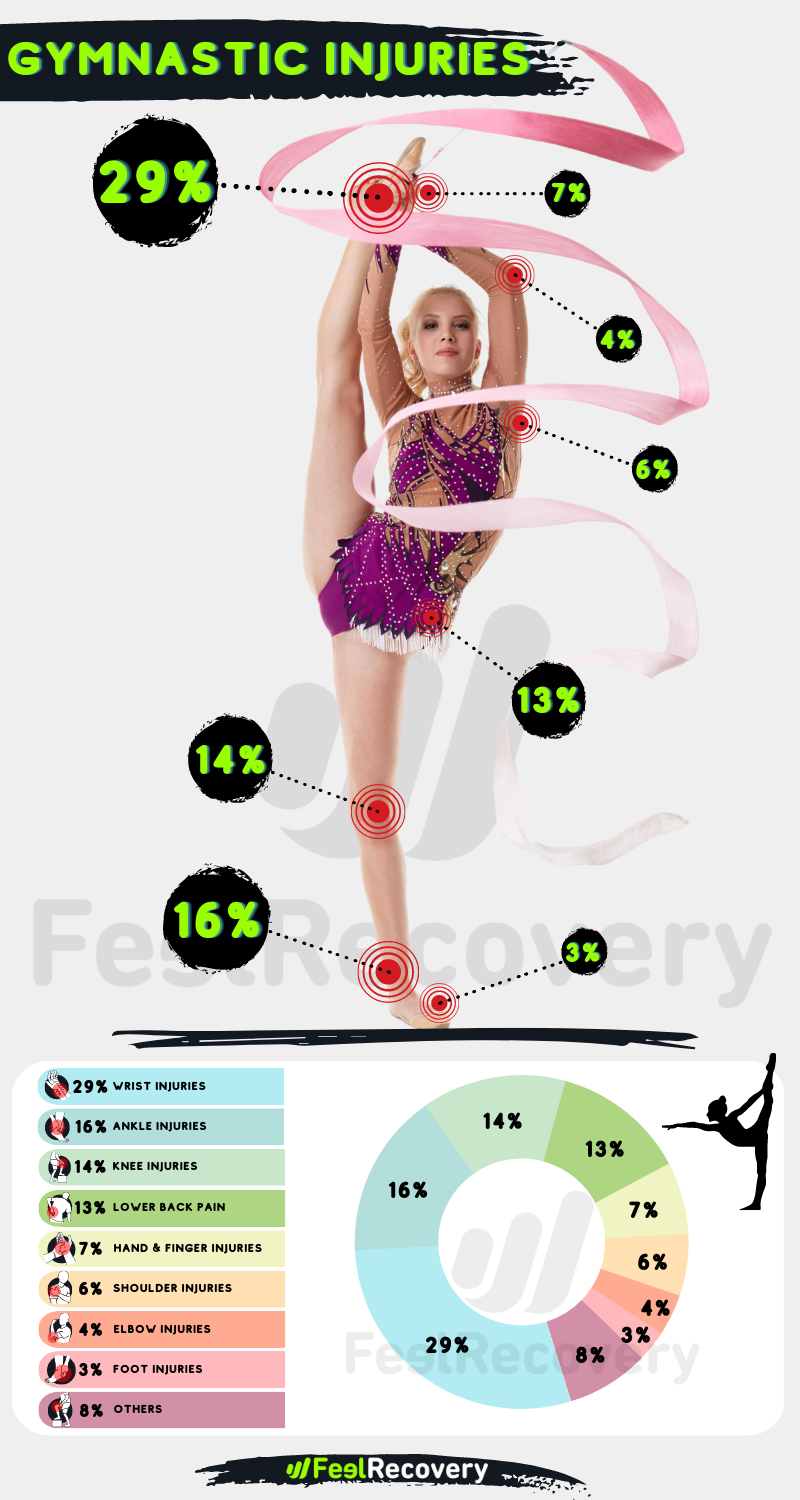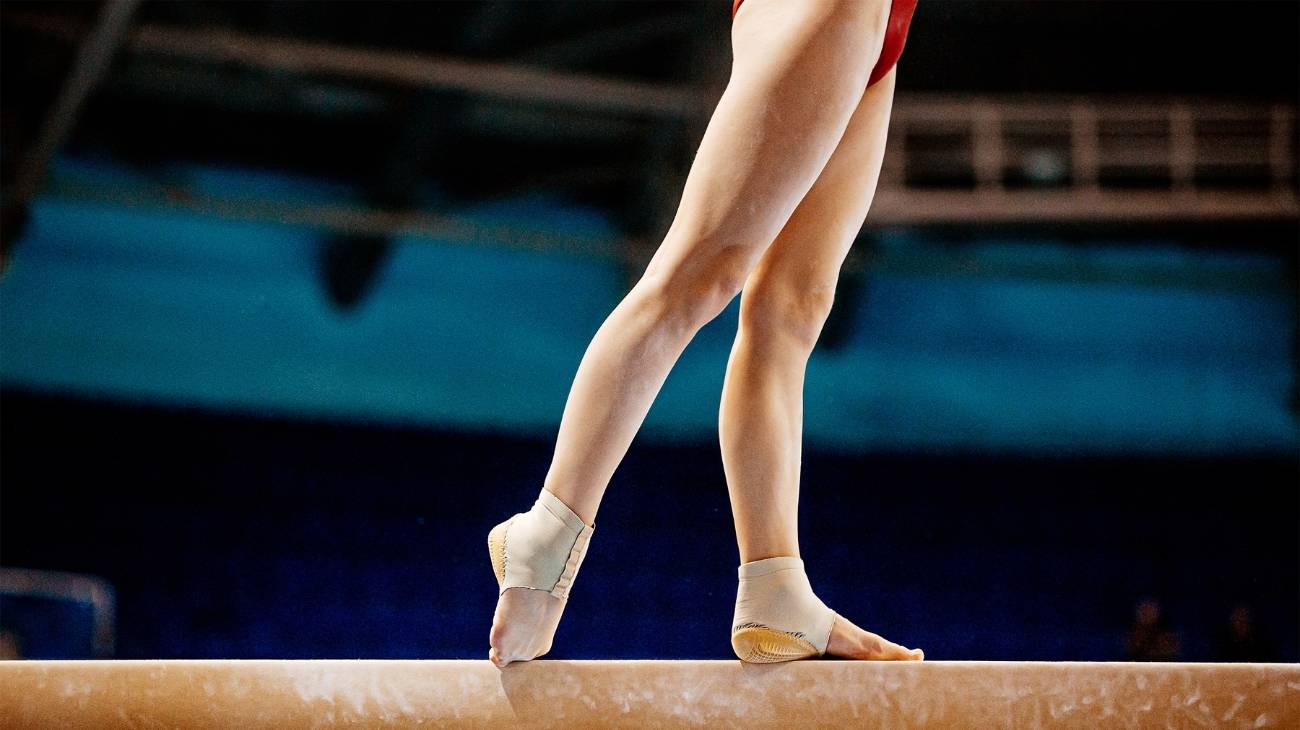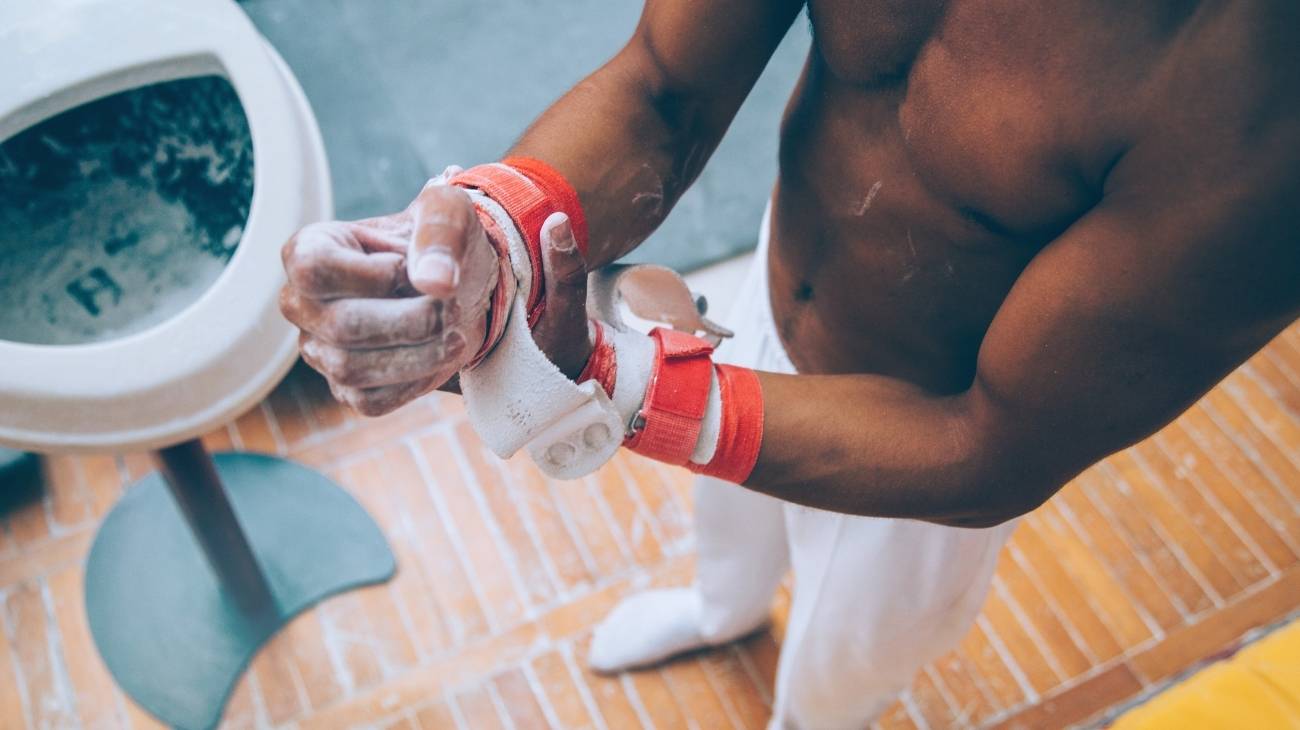Thousands of gymnastics injuries are treated in hospitals and clinics. Gymnasts must prepare themselves physically and emotionally for the demands of gymnastics because of the very demanding and complex exercises, the chances of suffering from injuries are quite high.
It is not common for injuries to become serious, but if the necessary measures are not taken, they can cause chronic pain and fractures. In this article we are going to introduce you to the most common injuries in sport and rhythmic gymnastics.
What are the most common types of injuries when training gymnastics?
Naturally, gymnastics is a physically intense sport, which poses a great risk for a wide range of injuries. Some of these are more common than others, below you will learn about the most common by their location on the body.
Hand and wrist injuries
Wrists are essential for gymnasts, it is important that they are strong to have the best possible grip on the hoops or acrobatic rings. But if this condition is not met, they can suffer many injuries such as the following:
- Carpal Tunnel Syndrome: when performing the corkscrew exercise in which the athlete must exert excessive pressure on the floor to stand on the hands without moving, this type of injury may arise, the same emanating from the pressure that is put on the hands and wrist, affecting the median nerve and the transverse carpal ligament.
- Tendonitis: this injury can arise from repetitive movements on the fixed or parallel bar which cause the tendons to collide and become inflamed.
- Wrist sprain: this is caused by exuberant stretching of the wrist ligaments through a fall that places the full load of the body on the wrist. It should always be evaluated to know its extent, as 100% of the time it causes damage to the ligaments, which can be partial or total.
Back injuries
The back is an extremely important muscular and bony complex that gives stability to the whole body and the constant landings due to the complex acrobatics that gymnasts perform can cause damage that if not controlled in time can affect the quality of life of the athlete.
- Arthrosis of the spine: this is a wear and tear of the discs located in the lumbar spine, with women being the most common sufferers of this serious injury. It is generated by years of exercise and physical wear and tear of a gymnast to perform.
- Lumbago: occurs due to the hyperextensions of the trunk that an athlete makes when practising this sport, which causes back pain, causing strong stiffness and limiting the gymnast's movements.
- Spondylosis: occurs due to a separation of the facet joint between the fifth and fourth vertebrae. A possible exercise that can cause this injury is the spinning on a treadmill, but it does not usually occur as a result of a single session of this exercise, but rather due to the constant performance of the same exercise with an inadequate technique.
Ankle and foot injuries
Lastly, the ankles and feet bear almost all the weight of the gymnasts landing after taking off from the ground to perform their acrobatics. Among the most common injuries are:
- Tendinitis of the Achilles tendon: this is caused by the overload that the gymnast may cause when jumping, or falling with all their body weight on one ankle, and another key factor is not warming up briefly during practice. This leads to immediate rest for at least 7 days.
- Sprains: falling badly on one of the ankles is the main cause of this injury, which causes the joint to twist and the ligaments to stretch too much, causing micro-tears or total tears that will be accompanied by inflammation and a lot of pain.
Best products for gymnastics injury recovery
Bestseller
-
2 Ankle Compression Sleeve (Black/Gray)
£17,50 -
2 Ankle Compression Sleeve (Green/Navy)
£17,50 -
2 Ankle Compression Sleeve (Pink/Bordeaux)
£17,50 -
2 Elbow Compression Sleeve (Black/Gray)
£17,50 -
2 Elbow Compression Sleeve (Green/Navy)
£17,50 -
2 Elbow Compression Sleeve (Pink/Bordeaux)
£17,50 -
2 Knee Compression Sleeve (Black/Gray)
£17,50 -
2 Knee Compression Sleeve (Green/Navy)
£17,50 -
2 Knee Compression Sleeve (Pink/Bordeaux)
£17,50 -
2 Thigh Compression Sleeve (Black/Gray)
£17,50 -
2 Thigh Compression Sleeve (Green/Navy)
£17,50 -
2 Thigh Compression Sleeve (Pink/Bordeaux)
£17,50 -
Acupressure Mat and Pillow (Black/Gray)
£44,95 -
Acupressure Mat and Pillow (Green/Navy)
£44,95 -
Acupressure Mat and Pillow (Pink/Bordeaux)
£44,95 -
Acupressure Pillow (Black/Gray)
£21,52 -
Acupressure Pillow (Green/Navy)
£21,52 -
Acupressure Pillow (Pink/Bordeaux)
£21,52 -
Foot Massage Roller for Plantar Fasciitis (Black)
£17,50 -
Foot Massage Roller for Plantar Fasciitis (Green)
£17,50 -
Foot Massage Roller for Plantar Fasciitis (Pink)
£17,50 -
High Density Foam Roller for Muscle (Black/Gray)
£24,95 -
High Density Foam Roller for Muscle (Green/Navy)
£24,95 -
High Density Foam Roller for Muscle (Pink/Bordeaux)
£24,95 -
Ice Massage Roller Ball (Black)
£34,95 -
Ice Massage Roller Ball (Green)
£34,95 -
Ice Massage Roller Ball (Pink)
£34,95 -
Microwave Wheat Bag for Neck & Shoulder Pain Relief (Hearts)
£21,50 -
Microwave Wheat Bag for Neck & Shoulder Pain Relief (Oxford)
£21,50 -
Microwave Wheat Bag for Neck & Shoulder Pain Relief (Sport)
£21,50 -
Microwave Wheat Bag for Neck Pain Relief (Hearts)
£17,50 -
Microwave Wheat Bag for Neck Pain Relief (Oxford)
£17,50 -
Microwave Wheat Bag for Neck Pain Relief (Sport)
£17,50 -
Microwaveable Wheat Bag for Pain Relief (Hearts)
£17,50 -
Microwaveable Wheat Bag for Pain Relief (Oxford)
£17,50 -
Microwaveable Wheat Bag for Pain Relief (Sport)
£17,50 -
Pack 2 in 1: Foam Roller High + Soft Density (Black/Gray)
£24,95 -
Pack 2 in 1: Foam Roller High + Soft Density (Green/Navy)
£24,95 -
Pack 2 in 1: Foam Roller High + Soft Density (Pink/Bordeaux)
£24,95 -
Soft Density Foam Roller for Recovery (Black)
£24,95 -
Soft Density Foam Roller for Recovery (Green)
£24,95 -
Soft Density Foam Roller for Recovery (Pink)
£24,95 -
Trigger Point Massage Stick (Black)
£12,95 -
Trigger Point Massage Stick (Green)
£12,95 -
Trigger Point Massage Stick (Pink)
£12,95
How to prevent injuries when practising rhythmic or sport gymnastics?
It is important to stress the importance of injury prevention in gymnastics or any other sport. There are many factors that can result in injury, from poor technique, poor nutrition, old injuries treated incorrectly, to misuse of training equipment or distractions that affect the athlete's concentration.
Listed below are some of the preventative factors that most affect whether or not sports injuries occur:
- Warm up properly: before being able to perform complex exercises such as the famous side somersault with jump or the inverted gymnastic rings, typical of this artistic sport, it is necessary to warm up beforehand, which includes the seesaw, the pino, and walking doing the pino, which is nothing more than walking on your head with your hands. With these movements the blood supply will reach an optimal state for the athlete to be able to perform in any area of gymnastics.
- Finish the workouts with a cool down: to end the training routine it is essential to give the body a small stretching session similar to the one at the beginning, this is done to bring the muscles to a state of relaxation and rest, you can also add a brisk walk of 5 minutes. In this way the body will progressively slow down the heart rate, the muscles will decongest and the body's stability will return.
- Good nutrition and hydration: nutrition is a very important point that should not be taken lightly when practising gymnastics, because without a balanced diet or a good balance between proteins and carbohydrates, the main joints of the body, which are responsible for the most powerful movements in gymnastics, will be weakened and may suffer various injuries. On the other hand, the athlete should not forget to stay hydrated before, during and after training.
- Improve your physical condition: depending on the type of gymnastics you do, it will be more necessary to have aerobic resistance, as in rhythmic or acrobatic gymnastics, or anaerobic resistance, as in classical gymnastics, where the gymnast must have total control of his or her body and control his or her weight 100%. For this reason, in addition to the training sessions, it is advisable to carry out specific training to optimise each of these qualities.
- Sports massage: the main purpose of this is to reduce tension in the muscles. It helps to reduce the risk of injury and shortens the time it takes for a muscle to repair itself. Not to be confused with a relaxing massage, it is not only limited to kneading the muscles, but also to releasing tension in the joints.
- Use of hot and cold therapies: with cold, vasoconstriction is generally sought in order to limit the extent of muscle inflammation, especially those that occur after an injury. As for heat, it has a vasodilator effect that improves the quality of blood supply to the muscles and joints, which strengthens them to make them less susceptible to future injury.
- Use of compression garments: this is basically the use of bandages or special garments to exert pressure on the muscles, which optimises blood circulation when training and also aids rehabilitation from inactivity. The leotards worn by gymnasts are elastic garments, which keep the muscles compressed to a certain extent, and minimise the impact generated during a performance.
- Use of acupressure therapies: this involves applying pressure to specific points on the body using the hands, elbows or fingertips, thereby releasing tension in a large area of the body. These points must be well known and how to stimulate them, so it is a technique that should always be applied by a trained professional.
- Use of thermotherapy and cryotherapy: the technique preferred by far, by physiotherapists and professionals in the area, for the treatment of injuries in a non-invasive way is cryotherapy and thermotherapy, since when the two are combined they can achieve effects of activation or relaxation of the muscles and joints of the body to enhance the performance of athletes. However, it has a whole science behind it and should never be taken lightly or applied as a home remedy as a bad practice in an inopportune circumstance can lead to a completely unexpected and counterproductive effect.
- Use of proper equipment: among the different equipment used there is the Tull heel cup, which cushions and protects the ankle of a barefoot from possible injury, tiger paws are essential to provide protection to the wrist as it is basic for every movement. The palms of the hands must be protected from calluses and therefore the use of grips should be implemented.
How to apply the RICE therapy to treat first aid injuries in gymnastics?
Currently P.R.I.C.E. (Protection, Rest, Ice, Compression and Elevation) is the new generation of the R.I.C.E. therapy, the latter being still the most popular.
Here are the steps to follow:
- Protection: this consists of not exposing the affected area to further injury or continued stress to avoid worsening the situation.
- Rest: by resting, this step allows the affected area to begin the natural recovery process and above all to avoid aggravating the injury through movement.
- Ice: the cold has a reducing effect on the congested area, and helps the injured person to feel less pain, but this practice is only beneficial if it is applied at intervals of 15 to 20 minutes with constant breaks of 1 to 2 hours.
- Compression: in this step a measure of containment is applied, using special bandages to prevent the sensation of swelling and pain from being prolonged, or with special garments such as ankle or knee braces depending on the joint or muscle affected.
- Elevation: this step consists of keeping either the limb or the area of the body that is affected above the heart, thus avoiding a strong flow of blood to the injured area and allowing the swelling to decrease in a faster and more natural way.
References
- Meeusen, R., & Borms, J. (1992). Gymnastic injuries. Sports Medicine, 13, 337-356. https://link.springer.com/article/10.2165/00007256-199213050-00004
- Caine, D. J., & Nassar, L. (2005). Gymnastics injuries. Epidemiology of pediatric sports injuries: individual sports, 48, 18-58. https://www.karger.com/Article/Abstract/84282
- Garrick, J. G., & Requa, R. K. (1980). Epidemiology of women's gymnastics injuries. The American journal of sports medicine, 8(4), 261-264. https://journals.sagepub.com/doi/abs/10.1177/036354658000800409
- Sands, W. A., Shultz, B. B., & Newman, A. P. (1993). Women's gymnastics injuries: a 5-year study. The American journal of sports medicine, 21(2), 271-276. https://journals.sagepub.com/doi/abs/10.1177/036354659302100218
- Caine, D., Cochrane, B., Caine, C., & Zemper, E. (1989). An epidemiologic investigation of injuries affecting young competitive female gymnasts. The American journal of sports medicine, 17(6), 811-820. https://journals.sagepub.com/doi/abs/10.1177/036354658901700616
- Cavallerio, F., Wadey, R., & Wagstaff, C. R. (2016). Understanding overuse injuries in rhythmic gymnastics: A 12-month ethnographic study. Psychology of sport and exercise, 25, 100-109. https://www.sciencedirect.com/science/article/abs/pii/S1469029216300516
- Zetaruk, M. N., Fors, M. V., Zurakowski, D., Mitchell Jr, W. A., & Micheli, L. J. (2006). Injuries and training recommendations in elite rhythmic gymnastics. Apunts: Medicina de l'esport, 100-106. https://www.raco.cat/index.php/Apunts/article/view/164833
- Daly, R. M., Bass, S. L., & Finch, C. F. (2001). Balancing the risk of injury to gymnasts: how effective are the counter measures?. British Journal of Sports Medicine, 35(1), 8-19. https://bjsm.bmj.com/content/35/1/8.short
- Sands, W. A. (2000). Injury prevention in women’s gymnastics. Sports medicine, 30, 359-373. https://link.springer.com/article/10.2165/00007256-200030050-00004
- Bradshaw, E. J., & Hume, P. A. (2012). Biomechanical approaches to identify and quantify injury mechanisms and risk factors in women's artistic gymnastics. Sports Biomechanics, 11(3), 324-341. https://www.tandfonline.com/doi/abs/10.1080/14763141.2011.650186




















































































